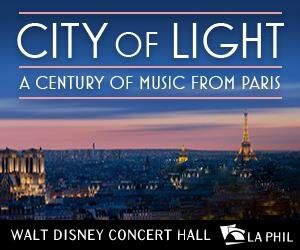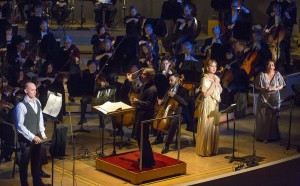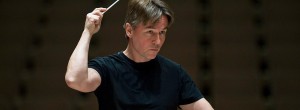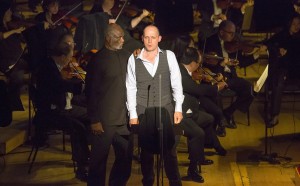THE CRASH OF SYMBOLISM
As part of its City of Light: A Century of Music From Paris series, the Los Angeles Philharmonic is presenting Debussy’s one-of-a-kind opera, Pelléas et Mélisande, in its entirety. Helmed by the rightfully popular Esa-Pekka Salonen, the LA Phil and Los Angeles Master Chorale will be joined by Kate Burton as the narrator, Stéphane Degout as Pelléas, Camilla Tilling as Mélisande, and the creative team behind Salonen’s resoundingly successful London production (which The Guardian called, “one of Salonen’s finest achievements”), including director David Edwards and lighting designer Colin Grenfell. The event is selling quite well and you only have two performances to see it: Friday, February 19, at 8 and Sunday, February 21, at 2.
The gorgeous music, with those scrumptious Debussy chords, is all there. But this innovative opera, the only one Debussy ever completed, contains some elusive melodies and even silence for effect. And despite its full length, the plot is brief, incidents few, characters simple, setting vague. The whole tale unfolds simply and with inexorable logic. I thought you should know why this is before you go, so that you can soak up this marvel of an opera without wondering, “What the ..?”
First performed in 1893, Pelléas and Mélisande is a Symbolist play by Maurice Maeterlinck about the forbidden, doomed love of the title characters. The Symbolists (they preferred it with a capitol “S”) were a group of chiefly French and Belgian poets of the latter part of the 19th century who sought to evoke aesthetic emotions by emphasizing the associative character of verbal, often private, images or by using synesthetic devices, such as vowel sounds, presumably evocative of color. In simpler terms, they had had enough of Naturalism, also known to us as “reality.” You see, Naturalism is largely based on Darwinian thinking, and since Divinity itself was challenged, these artists wanted to create an art form that wasn’t so bleak.
As Bill Morelock wrote, “No one really knew what Symbolism was, and that was how the Symbolists liked it. Providing the clueless with a road map really wouldn’t have been Symbolist.”
Symbolism was about mere suggestion, the indirect gesture, the dream-like vision. Like all things hip in all ages, you either got it or you didn’t. And since dream-like visions tend to be exempt from adhering to rules of structure, linearity and sense, Symbolism was very easy not to get.
The upshot was that we human beings contend, vainly, with forces too large for us even to perceive, much less overcome. But instead of cold Nature, Symbolism looked at human matrices, hierarchies, chance meetings, near misses, timing — and once the games began, documented all the emotional wreckage and deadly crimes of passion.
Belgian dramatist Maeterlinck sought a higher level of meaning than the literal. Rather, he vaunted suggestion over description, fleeting impressions over narration, fatalistic destiny over character motivation and naïve repetition over definitive pronouncements, all within a context of mysterious and mystical atmosphere.
His Symbolist manifesto for the stage begins in a misty ancient setting, a kingdom of shadows and memories called Allemonde. A 40-something prince named Golaud is out hunting the wild boar one day, as princes do, and gets lost. He comes across a frightened young woman by a spring. Mélisande weeps, and recoils even from the touch of his hand. She, too, is a princess, though far from home and uncertain how she got there. Yet, in the wink of an eye, the two are married. But Mélisande will soon meet the man she’s destined to love: Golaud’s half-brother Pelléas. The cards are dealt with a few vague gestures (the plot-building materials: reverie and fog), and the love triangle guarantees a succession of jealousies, rhapsodies and, ultimately, tragedies.
Pelléas and Mélisande fascinated composers. Maeterlinck and Symbolism were all the rage. Little wonder. Musical settings of literary texts usually involved the cutting of extraneous detail. Maeterlinck was kind enough to leave most everything out already. Symbolist tactics brought the phenomenal world, as described by words, and the visceral world, of which music was sovereign, closer than they’d ever been. Within a dozen years Gabriel Fauré, Claude Debussy, Arnold Schoenberg and Jean Sibelius would each give music to Pelléas and Mélisande.
Fauré was the first. He wrote his incidental music for the first British production of the play — at the request of the actress Mrs. Patrick Campbell — in June of 1898, five years after the Paris premiere. He had six weeks to complete the work and recycled some existing material. The famous Sicilienne Op.78 for cello and piano was born.
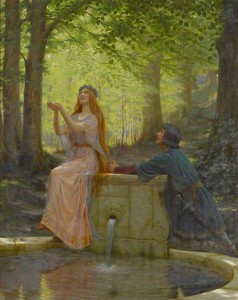 Debussy deliberately shuns the well-developed, memorable repeated phrases of conventional opera; enticing melodic fragments often flit by. Indeed, Debussy’s setting of the text — which is practically lifted from the play — constantly veers between casual conversation and stylized song.
Debussy deliberately shuns the well-developed, memorable repeated phrases of conventional opera; enticing melodic fragments often flit by. Indeed, Debussy’s setting of the text — which is practically lifted from the play — constantly veers between casual conversation and stylized song.
But if anyone mentions that Debussy’s opera wallows for its entire 2½ hour duration in a soft, understated monotone of stares and bland conversation, you will see this is untrue. While the mature adults (the doctor, Arkel and Golaud’s mother Geneviève) do restrain their expression, Yniold (Golaud’s young child by his first marriage) chirps perkily, the love scenes between Pelléas and Mélisande soar with unbridled passion and the grim tone of the final act serves as a foil for Golaud’s fitfully violent attempts to assess blame and find meaning in the tragedy he has caused. Indeed, the culmination of the fourth act, as the lovers spot Golaud and know they are doomed, is a musical orgasm, with ecstatic rising vocal phrases, accelerating rhythmic exhortations, a strong lingering embrace, a smoothly flowing orchestral release, and Mélisande gasping for a breath (“Je n’ai pas / de courage”) to blurt her final line as she flees.
In a mixture of modesty and pride, Debussy had written: “I do not pretend to have discovered everything in Pelléas; but I have tried to trace a path that others may follow, broadening it with individual discoveries which will, perhaps, free dramatic music from the heavy yoke under with it has existed for so long.” Yet, having forged a radical new course in Pelléas that seemed to burst with further possibilities to liberate the genre from the formal structures and conventions of the prior three centuries, Debussy never pursued it himself in another opera. That would be left to others. The influence of Pelléas far outshone its limited early success. André Messager, the conductor of the premiere, said: “When Melisande asks for the window to be opened in the last scene, she let in not only the sunset but all modern music.”
photos of Chicago Symphony Orchestra production by Todd Rosenberg
Pelléas et Mélisande
Los Angeles Philharmonic
Esa-Pekka Salonen, conductor
David Edwards, director
Colin Grenfell, lighting designer
Kate Burton, narrator
Stéphane Degout, Pelléas
Camilla Tilling, Mélisande
Laurent Naouri, Golaud
Sir Willard White, Arkel
Felicity Palmer, Genevieve
Chloé Briot, Yniold
Nicholas Brownlee, Physician
Los Angeles Master Chorale, Grant Gershon, artistic director
Friday, February 19, 2016 at 8
Sunday, February 21, 2016 at 2
for tickets, call 323.850.2000 or visit LA Phil
